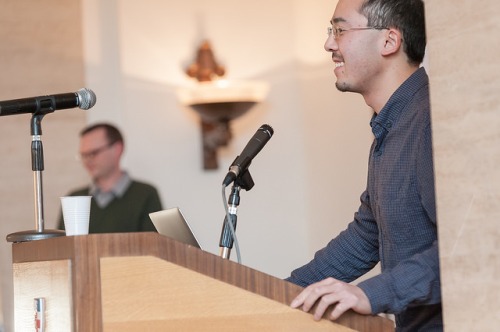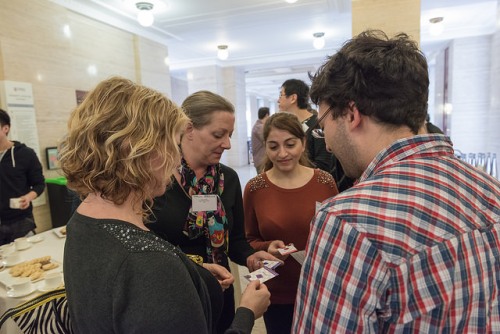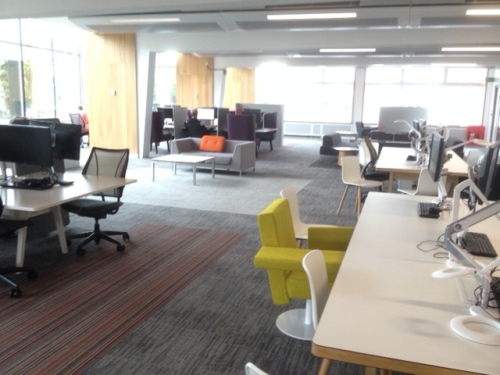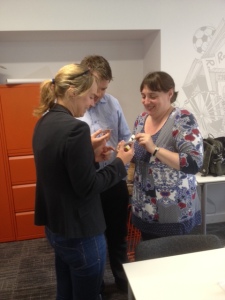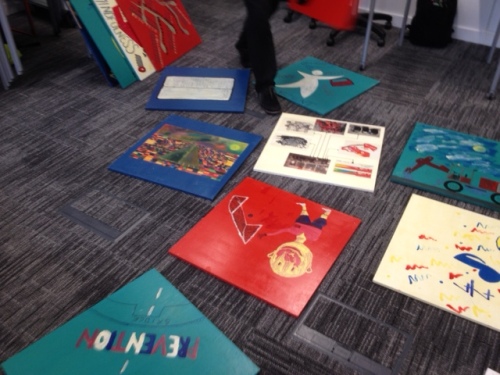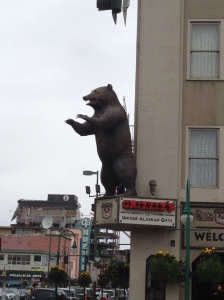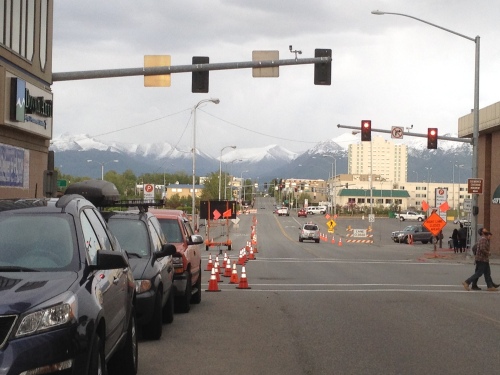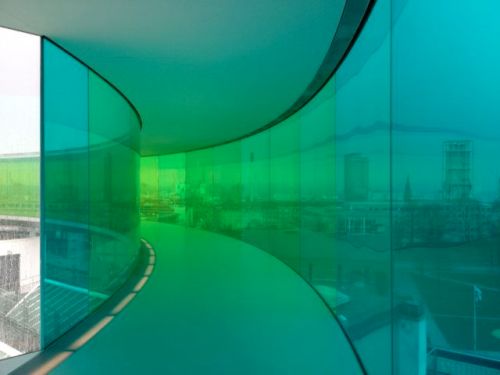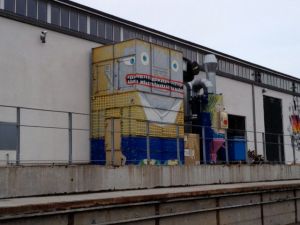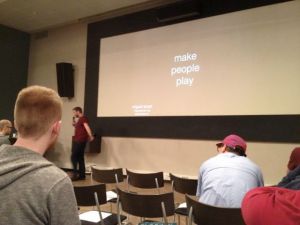Following my research and teaching trips, culminating at the harbour of the increasingly beautiful and cosmopolitan Aarhus, I arrived in plenty of time for the beginning of Counterplay 17. Not that I needed to worry, as the wonderful Mathias Poulsen (who almost single-handedly forms this playful bubble into existence each year) opened proceedings by telling us that playful people tend to be late.
 This was followed by a blast of an opening by Anthea Moys, who herself arrived late on the stage – climbing and apologising to everyone she trampled over; and then proceeded to ask us to do the same, to find our actual seats. When we found them, we had to draw our neighbour’s faces without looking down at our paper. A great start that set the tone for the whole conference, this was just one of Anthea’s examples of her incredible playful art projects in Johannesburg.
This was followed by a blast of an opening by Anthea Moys, who herself arrived late on the stage – climbing and apologising to everyone she trampled over; and then proceeded to ask us to do the same, to find our actual seats. When we found them, we had to draw our neighbour’s faces without looking down at our paper. A great start that set the tone for the whole conference, this was just one of Anthea’s examples of her incredible playful art projects in Johannesburg.
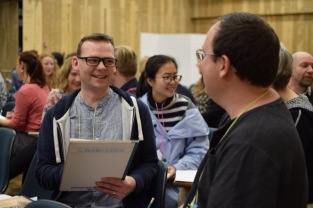
Anthea had us climbing, apologising and drawing
She mastered twelve different sports and then played, single-handedly, against twelve first teams. Her aim was to accept and stare failure in the face; and redefine success as the act of learning and playing, rather than failing to win. An approach that resonated with many, and created ripples of discussion about failure over the rest of the day. Gwen Gordon followed Anthea; a former Muppets puppeteer, who now uses play to improve lifestyles.
My session was next. I’m currently interested in the ‘invitation to play’; or what causes people to accept a playful activity, or reject it. I therefore had an idea about introducing elements of play into a non-playful scenario played out in every institution across the world: the board/committee meeting. We started with Apologies (apologising for something non-playful we do within our jobs), Introductions (giving each other fictitious names and roles) and the minutes of the last meeting – the 50 pages of which happened to be distributed across each attendees’ pack in random order. After that, things got very strange; as attendees tried to complete secret missions whilst creating their own playful approaches within the meeting room. It was really difficult to remain seated and straight-faced, as I decided the Chair should do.
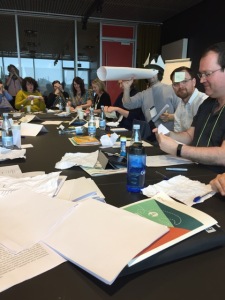
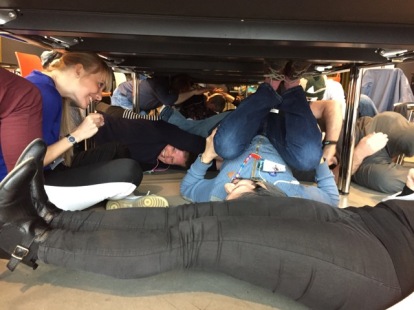
After lunch, and meeting up with old and new friends from across Europe, I attended Luca Morini‘s session on playfully hacking serious systems. Luca had us exploring the fabulous venue of Dokk1 (the huge and open public library that Counterplay occupies, in amongst the daily life of thousands of local students and families) in order to find places that were closed to us, for some reason. He used this as a way to introduce his idea that formal systems are game-like: they follow rules and states – and therefore can be gamed themselves.
An energetic keynote next from Portia Tung, who shared her approach to introducing play into corporate boardrooms. And then it was time to launch the first Counterplay book, The Power of Play, including articles, games and activities from many attendees of last year’s conference (myself included). It’s a beautiful, thoughtful and creative book – which I’m still leafing through and finding new interesting things to do and think about.

In the evenings we all headed to the excellent new Aarhus Street Food area, with stalls selling food from around the world, and good local craft beer to match. It was here that much of the creative thinking and networking went on each evening.
Day two dawned, and two of the people I’d been talking to at length in the evening were speaking: Kirsten Anderson, who had us all blowing bubbles; and Dom Breadmore from Coventry University, who gave a great talk about the invitation to play, and the importance of designing playable experiences, rather than playful ones (more agency in the former, when they invite interaction). I spent the rest of the morning exploring all the activities around Dokk1 outside the formal programme, including catching up with Rikke and Claus from Coding Pirates, who were working with children on creating Viking-themed games.
 After lunch we became future explorers, heading out into the city in small teams to help Eva (a fictional character we created based on the hashtag #finding4eva) create a map of future elements within the city. This was part of an ongoing project by Dan Barnard, and gave us a new way to explore the city’s hidden areas, as well as thinking about environmental issues and future planning. Also, our team won (yay!).
After lunch we became future explorers, heading out into the city in small teams to help Eva (a fictional character we created based on the hashtag #finding4eva) create a map of future elements within the city. This was part of an ongoing project by Dan Barnard, and gave us a new way to explore the city’s hidden areas, as well as thinking about environmental issues and future planning. Also, our team won (yay!).
It was then time for the final keynotes. Lena Mech followed the theme from the earlier workshop by using examples of playful work in cities to suggest that the invitation to play is more complex than we might think: we shouldn’t, she suggests, be arrogant in thinking that everyone can play, and should instead use ludic markers to tempt them in: whether human activity, or physical attributes in the landscape. Finally, returning four years on after his first (excellent) keynote at the first Counterplay, Miguel Sicart was back to pace the stage again. Like a prowling tiger, Miguel added what – in my opinion – could have been the last chapter of his book: a call to arms. He used examples of playful/creative groups that have worked against dictatorships or regimes to show us that small personal or group actions can start to work against dominant negative forces. A fabulous finish to the formal programme.

As last year, there was a further day of creative play following the main conference – so about half of us returned on the Saturday to consolidate our thinking around this year’s emergent themes. My group was thinking about setting seeds and growing playful approaches outside of the conference; and we came up with the idea to connect different people together with a tangible artefact – a package that would be sent between us with something to apply to our own context, and then add something else before sending it on (see Marian’s explanatory post).
In amongst the thinking, I also attended a final session by Mikel Haul, who has been researching the origin and development of the Chase the Goose popular game from the Ancient Greeks. His plan is to create a physical version of the board game, including its iconic squares (such as death, or the well), at spaces in Middlesborough, Tokyo, and Aarhus: and so we helped him by mapping out the board over the circular levels of Dokk1.
And that was it, although many played on well into the night – and through the flights home. It was, yet again, an incredible experience: almost all due to the people who attend from across the world with a common ethos – I made many new friends and colleagues who I’ll be carrying on the thinking and conversations with as the year progresses. Huge thanks to everyone who was there and made it such an incredible experience – and in particular to Mathias and his team of helpers, without whom this wonderful event wouldn’t occur.
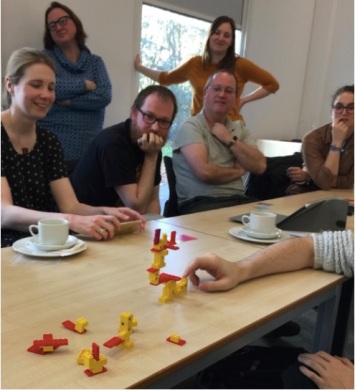


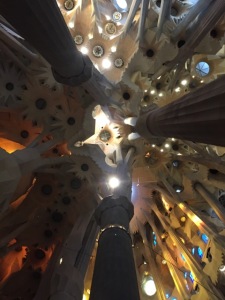





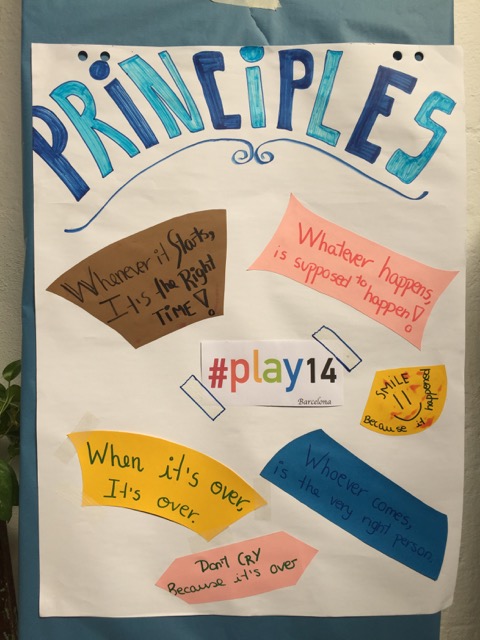

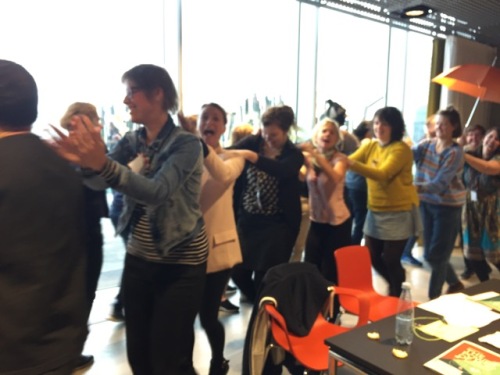
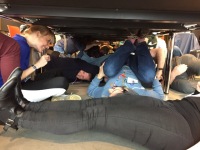
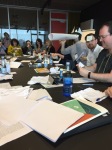

 This was followed by a blast of an opening by
This was followed by a blast of an opening by 



 After lunch we became future explorers, heading out into the city in small teams to help Eva (a fictional character we created based on the hashtag #finding4eva) create a map of future elements within the city. This was part of an ongoing project by
After lunch we became future explorers, heading out into the city in small teams to help Eva (a fictional character we created based on the hashtag #finding4eva) create a map of future elements within the city. This was part of an ongoing project by 

